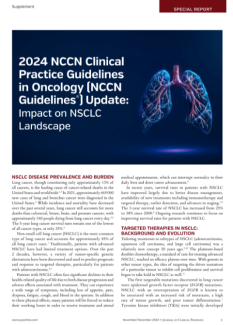Developing a National Pathway Framework for Prostate Cancer: Insights from Solaris Health
Jason Hafron, MD, discusses how Solaris Health developed and implemented standardized, National Comprehensive Cancer Network (NCCN)-based prostate cancer pathways across its national network to ensure consistent, high-quality care, streamline diagnosis, and drive improvements through metric-driven adherence and outcomes evaluation.
Please introduce yourself by stating your name, title, and any relevant clinical experience you’d like to share.
Jason Hafron, MD: Hi, I am Dr Jason Hafron. I'm a urologist in southeast Michigan. I'm also the Chief Medical Officer of the Michigan Institute of Urology and the codirector of the clinical board for Solaris Health.
Can you walk us through the current state of prostate cancer care pathways across the US, and what specific gaps Solaris Health set out to address?
Dr Hafron: Current pathways for prostate cancer are pretty much based on the National Comprehensive Network (NCCN) guidelines, which are updated twice a year. That's what most people follow—most importantly, that's what the payers follow. That helps us with getting reimbursed appropriately and getting therapies approved.
As far as Solaris Health, we've taken a significant commitment to pathway utilization in prostate cancer. Approximately 2 years ago, across the platform of 700 providers, we developed our own clinical pathways, which were essentially based on the NCCN guidelines or the American Urological Association (AUA) [guidelines]. This was developed by our prostate cancer committee. The prostate cancer committee or clinical board represents all of our affiliates across the country. Again, we're in 14 states right now, and we involved all the key opinion leaders, physicians, as well as nurse practitioners, in developing these pathways.
Through this pathway review, reviewing the NCCN guidelines, we develop the pathways and currently have them online and available to every one of our providers, either in the office or even on their phone.
How does Solaris Health’s pathway streamline the transition from abnormal PSA result to definitive diagnosis, and what has been the measurable impact on time to diagnosis?
Dr Hafron: Based on our pathways, we have a streamlined approach so that whether a patient is seen in Spokane, Washington, Michigan, or New York, they're essentially treated the same. That's based on the current guidelines. Because we have pathways in place, our doctors are more likely to be more efficient and get the appropriate testing so that the patients can get appropriate biopsy when needed.
How are diagnostic tools such as multiparametric MRI (mpMRI) and prostate biopsy integrated into the pathway to support risk stratification and avoid overtreatment?
Dr Hafron: Right now, we extensively use mpMRI in our pathway. It is a screening tool and has quickly evolved into the standard of care for elevated prostate-specific antigen (PSA), but we also use a lot of biomarkers.
What we've seen in the community is there's a wide variability in the quality of the mpMRI readings. We tend to use a lot of biomarkers to help us better identify patients with clinically significant prostate cancer, patients that do require a biopsy. It's a combination of biomarker or adjuvant PSA testing based on the NCCN guidelines, as well as mpMRI, that are all predetermined in our pathways.
In what ways does your model ensure consistency and quality of care across Solaris Health’s large, multisite provider network?
Dr Hafron: The first step for us was developing the pathways, which we did in 2023. The next step that we've been working very extensively on over the last year is measuring pathway adherence.
It's one thing to have a pathway in place, but it's really great when you have physicians who follow it closely, which essentially will lead to better outcomes. In the last 2 years or so we've been developing, with our IT teams, analytic programs to monitor pathway adherence to make sure that our patients, when they see any Solaris provider, get the highest quality of care.
Looking ahead, how is Solaris Health evolving its pathway to incorporate emerging technologies or data-driven insights that may further improve early detection and treatment selection?
Dr Hafron: We're extensively focused on developing metrics for pathway adherence. We talk a lot about the importance of being metric driven. That's the new world of clinical medicine; it is looking at metrics extensively.
What we do is we constantly talk and work with our physicians, reminding them that the metrics aren't to show that you're a good or bad doctor—they’re essentially feedback and give you opportunities to improve. Metrics don't improve care, but they point to gaps or deficits that need to be corrected. We work a lot with the administrative teams in our various affiliates, reviewing the metrics and identifying whether it's a gap in education, a gap in process—whatever it is—to focus on improving the metrics, to improve the quality of care.
That's where we are today and will be for this year. But I think what we're also developing in parallel is critically evaluating our outcomes. We developed the pathways, we measure adherence, but are these the best pathways? Do they lead to the best clinical outcomes? What we started preliminarily and have done in some pilot studies is how much or how well do these pathways and adherence to these pathways improve the quality of care? That's probably where we'll go in 2026.
© 2025 HMP Global. All Rights Reserved.
Any views and opinions expressed are those of the author(s) and/or participants and do not necessarily reflect the views, policy, or position of the Journal of Clinical Pathways or HMP Global, their employees, and affiliates.



















